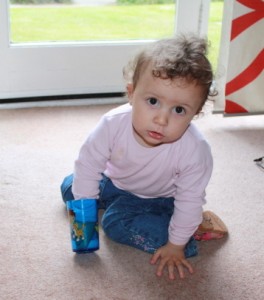August 5th, 2008
to make httpd work and avoid the selinux headaches :
setsebool httpd_disable_trans 1
setsebool httpd_can_network_connect_db=1
service httpd restart
For the FTP server ( vsftpd )
setsebool -P ftpd_disable_trans 1
service vsftpd restart
Posted in Linux | No Comments »
July 20th, 2008
Took Asma to see the Mela Asian Festival in Southampton, but looks that she didn’t like the sound of music ? or wanted to have some sleep by putting her fingers into her ears.

Posted in Family | No Comments »
July 12th, 2008
A photo taken using an SLR camera.

Posted in Family | 1 Comment »
May 22nd, 2008
In recent years, automatic visual surveillance has received considerable interest in the computer vision community. This is due to the increasing numbers of crimes from robbery to terrorist attacks, as well as the inability of human operators to monitor the increasingly growing numbers of surveillance cameras deployed in security sensitive areas such as government buildings and airports, or public places such as shopping malls and streets. According to the British Security Industry Association, the number of CCTV cameras installed in the UK was estimated to be more than 4.25 million in 2004; this figure is expected to grow rapidly particularly after the terrorist attacks that London witnessed in July 2005. Despite the huge increase of surveillance systems, the question whether current surveillance systems work as a deterrent to crime is still debatable. Security systems should not only be able to predict when a crime is about to happen but, more importantly, they ought to identify the individuals suspected of committing crimes, say through the use of biometrics such as gait recognition.
Posted in Research | No Comments »
April 16th, 2008
Feature subset selection is the process of choosing the variables that are important for the classification stage from the original feature space. Feature selection is an important task for almost any pattern recognition problem (Webb, 1999). This procedure is aimed to derive as many discriminative cues as possible whilst removing the redundant and irrelevant information which may degrade the recognition rate. Furthermore, feature selection does not only reduce the cost of recognition by reducing the dimensionality of the feature space, but also offers an improved classification performance through a more stable and compact representation (Jain 1982). It is practically infeasible to run an exhaustive search for all the possible combinations of features in order to obtain the optimal subset for recognition due to the high dimensionality of the feature space. For this reason, it is recommended to use a feature selection algorithm as the Adaptive Sequential Forward Floating Selection (ASFFS) search algorithm (Pudil 1994).
The feature selection procedure fundamentally relies on an evaluation function that determines the usefulness of each feature in order to derive the ideal subset of features for the classification phase. For every feature or set of features generated by the feature selection algorithm, an evaluation criterion is called to measure the discriminative ability of the set of features to distinguish different subjects (Dash 1997). A number of methods (Mowbray, 2003) rely mainly on statistical metric measures which are based on the scatter or distribution of the training samples in the feature space such as the Bhattacharyya metric. These methods aim to find the features which minimize the overlap between the different classes as well as the inner-class scatter.
Posted in Research | No Comments »
April 15th, 2008
After playing and making a lot of noise! There comes a judgment day for her! Immunization which made her cry for about half an hour, then fell asleep! Then back to noise and trouble making again!.

And another photo as she is trying to stand up !

Posted in Family | No Comments »
April 15th, 2008
Since the adaptive background subtraction lacks capability to remove shadows, it is recommended using the approach described by Cucchiara (2003) to evaluate whether a foreground pixel corresponds to cast shadow based on the Hue Saturation Value (HSV) colour information. The chromaticity and luminosity of the foreground pixels are separated using the HSV colour space which is proved to match the human perception of colour more closely than the RGB model (Herodotou, 1998). The method proposed by Cucchiara et al assumes that shadows reduce surface brightness and saturation while maintaining chromaticity properties in the HSV colour space.
Posted in Research | No Comments »



















